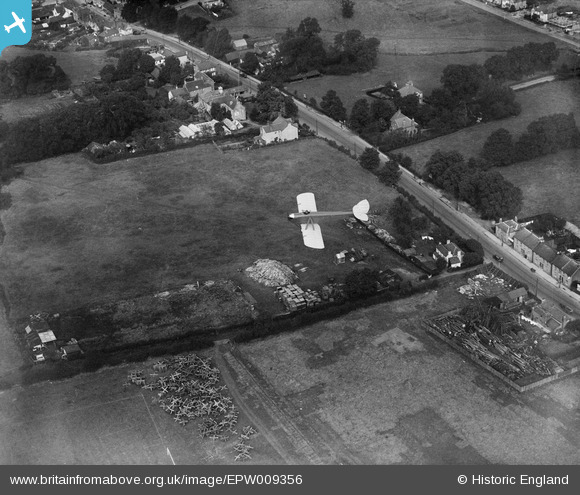EPW009356 ENGLAND (1923). A DH53 in flight over Bacon Lane and the Edgware Road, Little Stanmore, 1923
© Copyright OpenStreetMap contributors and licensed by the OpenStreetMap Foundation. 2026. Cartography is licensed as CC BY-SA.
Nearby Images (11)
Details
| Title | [EPW009356] A DH53 in flight over Bacon Lane and the Edgware Road, Little Stanmore, 1923 |
| Reference | EPW009356 |
| Date | 1923 |
| Link | |
| Place name | LITTLE STANMORE |
| Parish | |
| District | |
| Country | ENGLAND |
| Easting / Northing | 519515, 191108 |
| Longitude / Latitude | -0.27398005580561, 51.60563761818 |
| National Grid Reference | TQ195911 |
Pins

Class31 |
Tuesday 26th of November 2013 09:30:07 AM | |

Dave Brunt |
Monday 24th of June 2013 11:58:53 PM | |

Dave Brunt |
Monday 24th of June 2013 11:48:21 PM | |

Dave Brunt |
Monday 24th of June 2013 11:46:19 PM | |

Dave Brunt |
Monday 24th of June 2013 11:45:19 PM | |

Dave Brunt |
Monday 24th of June 2013 11:44:50 PM | |

Dave Brunt |
Monday 24th of June 2013 11:44:04 PM | |

Dave Brunt |
Monday 24th of June 2013 11:43:37 PM | |

Dave Brunt |
Monday 24th of June 2013 11:43:03 PM |
User Comment Contributions
Further to Kate's comments. I rather doubt if they carried wire on such large "bobbins". Drums were used for cables and wire the same but smaller than this. The mention of wire made me wonder if they were some sort of army surplus from the end of hostilities only five years before. How much of this sort of stuff got repatriated for France? I rather doubt if this timber has anything to do with setting out a linear construction site. I suspect in those days two simple wire fences were run along the outside of the surveyed route allowing for cuttings and embankments, and the work commenced in full view, unlike today hoardings and security fencing. It would be a very tall fence if the wooden track was feather boards.... and it is rather over grown. |

Maurice |
Sunday 1st of September 2013 06:03:07 PM |

colsouth111 |
Sunday 1st of September 2013 05:45:32 PM | |
"Now all we need to know is, what are those large timber cross-pieces in the bottom left of the image!" What have we got? There is clearly a lot of activity relating to wood in this picture. There is the discrete yard to the right on Burnt Oak Broadway, that has a good stock of un-sawn timber but on sign of a sawing mill to process the wood. In the field next to this there appears to be some rough stacks of timber, some of which seems to be parts for sectional buildings or frameworks of the type used in construction. In the field below the plane there is a large heap of sawn timber which seems to be odds lengths, suggesting off cuts; but off cuts from what process? Next to this there seems to be a stack of large packing cases, those fairly neatly stacked could be bundles of wood, but the outliers are more suggestive of crates. The right of this is a wooden cart and another heap of frames or crates. Just by the wing tip of the plane there is what appears to be a newly built wooden hut, as yet without any roofing material applied. There are several more carts and over the hedge some more unsorted heaps of wood, frames and building. (The washing in this garden might suggest it is a Monday - which does not help much.) Moving the left of the picture there appears to a shelter of the sort used by wood workers - a roof with open sides - surrounded by other buildings and heaps of timber Including the first of the wooden cruciform pieces. These building stand at the end of patch of ground that is clearly not grazed or cut in the way the field behind the plane is managed. There several rough heaps of sawn timber on this piece of ground. Below this in the picture is the corner of a well marked out football pitch and part of a goal post. At the right hand edge of this field is what appears to be a wooden track made of timbers of the same size laid on the ground at a fairly close spacing. At the top end of this, close to the gateway, some of the same sized timbers are more angled and finally some are in a heap to the right. This 'track' seem to be disregarded as there are wheel tracks to the left. This cart track is the only thing at gives a reliable indication of the size of the Cruciform pieces. It suggests the pieces are about 6 feet by 6 feet, this being supported by the size of the corner quadrant on the football pitch. There are several different configurations of these relatively large bulks of timber, scaled out at between 6 to 9 inches square. Some are just a plain cross, while others have a thin circular fitting around the crossing and others have braces across between the arms making a square around the centre. There is evidence that some of the arms have strapping around them. These features suggest these frame were designed to take some sort of load. Some are neatly stacked while the majority seem to have just been thrown out of the cart that brought them here! So what are they? It is 1923. What was going on in north west London in 1923 that might produces this collection of similar pieces? Both the Bakerloo Line to Stanmore and the Northern Line to Edgware were under construction in the previous year or two. However, there is not a lot that suggests any link to tunnel construction about this heap of wood as the shield method of cutting tunnels through the London Clay does not require any form of centring. Around the same time the construction of the Wembley Stadium and the British Empire Exhibition was taking place. I wonder if these cruciforms are part of the construction support of some of the plentiful amount of concrete work on these two projects... especially the Stadium as this was built by 'Concrete Bob' - Sir Robert McAlpine. If my late father was still around I could ask him as he worked on the site as a quantity surveyor. His shape eye might just have recorded such things. But, at ninety years distance I suspect we will never know if this is the origin of this pile of crosses. This rather rambling contribution may seem rather useless, but it was about half way through the analysis of "What have we got?", that the idea of a large engineering project 'floated' into mind. Now there is another possibility ... The King George V Docks were opened in 1921... another source of used construction materials? Do we have a timber recycling depot? This comment probably holds the record for the longest and most unproductive contribution to Britain from Above! It does however prove that one needs more than just aerial evidence to draw a complete conclusion. |

Maurice |
Tuesday 27th of August 2013 10:38:27 PM |
Hi Maurice, Your thoughts on this are really interesting and I feel that thinking about these large, cruciform objects as by-products of some other process is a good avenue to follow. They are really rather large. In that big pile near the football pitch, some are stacked neatly but the rest seem to have been dumped. I think the nearby "track" is perhaps a chestnut paling fence, lying on the ground. I have wondered if the cruciform objects could be something to do with wire, but I can't really think how...but plenty of reels of fencing wire must have been required to fence off, for example, the easement for the nearby railway line (which we see around Burnt Oak station being built in so many Aerofilms images of the period). Does anyone know anything about the processes and equipment used in preparing a big, linear engineering scheme in the 1920s? Katy Britain from Above Cataloguing Team Leader |
Katy Whitaker |
Tuesday 27th of August 2013 10:38:27 PM |
Hi Dave, Thanks for the pins to confirm the location. Now all we need to know is, what are those large timber cross-pieces in the bottom left of the image! We'll update the catalogue, and post the new record here in due course. Yours, Katy Britain from Above Cataloguing Team Leader |
Katy Whitaker |
Monday 1st of July 2013 01:19:23 PM |


![[EPW009356] A DH53 in flight over Bacon Lane and the Edgware Road, Little Stanmore, 1923](http://britainfromabove.org.uk/sites/all/libraries/aerofilms-images/public/100x100/EPW/009/EPW009356.jpg)
![[EAW028464] The Edgware General Hospital and the surrounding residential area, Burnt Oak, 1950](http://britainfromabove.org.uk/sites/all/libraries/aerofilms-images/public/100x100/EAW/028/EAW028464.jpg)
![[EPW009359] A De Havilland DH.53 "Humming Bird" in flight over Bacon Lane, Little Stanmore, 1923](http://britainfromabove.org.uk/sites/all/libraries/aerofilms-images/public/100x100/EPW/009/EPW009359.jpg)
![[EPW016827] The Hawkes and Co. Musical Instrument Works, Burnt Oak, 1926](http://britainfromabove.org.uk/sites/all/libraries/aerofilms-images/public/100x100/EPW/016/EPW016827.jpg)
![[EPW001355] The High Road, Burnt Oak, 1920](http://britainfromabove.org.uk/sites/all/libraries/aerofilms-images/public/100x100/EPW/001/EPW001355.jpg)
![[EPW016826] The Hawkes and Co. Musical Instrument Works, Burnt Oak, 1926](http://britainfromabove.org.uk/sites/all/libraries/aerofilms-images/public/100x100/EPW/016/EPW016826.jpg)
![[EPW016825] The Hawkes and Co. Musical Instrument Works, Burnt Oak, 1926](http://britainfromabove.org.uk/sites/all/libraries/aerofilms-images/public/100x100/EPW/016/EPW016825.jpg)
![[EPW020054] Redhill County Hospital, Burnt Oak, 1927](http://britainfromabove.org.uk/sites/all/libraries/aerofilms-images/public/100x100/EPW/020/EPW020054.jpg)
![[EPW020056] Redhill County Hospital and High Road, Burnt Oak, 1927](http://britainfromabove.org.uk/sites/all/libraries/aerofilms-images/public/100x100/EPW/020/EPW020056.jpg)
![[EAW028465] The Edgware General Hospital and the surrounding residential area, Burnt Oak, 1950](http://britainfromabove.org.uk/sites/all/libraries/aerofilms-images/public/100x100/EAW/028/EAW028465.jpg)
![[EPW020055] Redhill County Hospital, Burnt Oak, 1927](http://britainfromabove.org.uk/sites/all/libraries/aerofilms-images/public/100x100/EPW/020/EPW020055.jpg)
